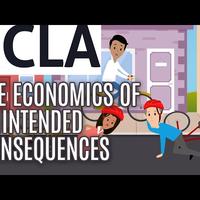Essential UCLA School of Economics: The Economics of Unintended Consequences
|||||||||последствия
||||||||niezamierzonych|
||||||||意図しない|
||Escola|||||||
Wesentliche UCLA School of Economics: Die Ökonomie der unbeabsichtigten Folgen
Lo esencial de la Facultad de Economía de la UCLA: La economía de las consecuencias imprevistas
Podstawy ekonomii UCLA School of Economics: Ekonomia niezamierzonych konsekwencji
Essencial da Escola de Economia da UCLA: A economia das consequências imprevistas
Школа экономики Калифорнийского университета: Экономика непреднамеренных последствий
Temel UCLA Ekonomi Okulu: İstenmeyen Sonuçların Ekonomisi
Essential UCLA School of Economics: Економіка непередбачуваних наслідків
加州大学洛杉矶分校经济学院必修课:意外后果经济学
Welcome to the essential ideas of the UCLA School of Economics.
UCLA Ekonomi Okulu'nun temel fikirlerine hoş geldiniz.
Many people assume that regulations designed to achieve a specific result
Muitas pessoas partem do princípio de que os regulamentos concebidos para alcançar um resultado específico
Birçok kişi, düzenlemelerin belirli bir sonuca ulaşmak için tasarlandığını varsayar.
Багато хто вважає, що нормативно-правові акти, розроблені для досягнення конкретного результату
—say increased safety—will actually achieve that intended outcome.
||||||||результат
||safety||||||
|||||||zamierzony|wynik
-digamos, o aumento da segurança- atingirá efectivamente o resultado pretendido.
-скажімо, підвищеної безпеки - насправді досягне цього запланованого результату.
But economist Sam Peltzman, a key member of the UCLA School of economics,
|economist|||||participant||||||
thought that because human behaviour is so complex,
regulators cannot anticipate all the consequences of their regulations,
authorities||||||||
||予測する||||||
||przewidzieć||||||
||predvideti||||||
as entidades reguladoras não podem prever todas as consequências dos seus regulamentos,
регулятори не можуть передбачити всіх наслідків своїх нормативних актів,
and therefore regulations might not achieve their intended results.
||||||||результатов
|||||||zamierzonych|
а отже, регулювання може не досягти запланованих результатів.
They may even achieve the exact opposite. Let's explore this idea using the example of
||||||przeciwieństwo||||||||
safety regulations for cars from Peltzman's own research.
|||||Peltzman (1)||
normas de segurança para os automóveis a partir da investigação do próprio Peltzman.
In the mid-to-late 1960s, the United States federal government wanted to reduce traffic
|||||||||national|||||
||中頃||||||||||||
||połowie||||||||||||
fatalities and serious injuries from car accidents.
死亡者||重傷||||
ofiary śmiertelne||||||wypadków samochodowych
smrtnost||||||
So the government mandated a number of safety features, including seat belts for all
|||||||segurança|características|||||
|||||||||||safety straps||
|||義務付けた||||||||||
|||nakazała||||||||pasy bezpieczeństwa||
Por isso, o governo impôs uma série de medidas de segurança, incluindo cintos de segurança para todos
Тому уряд запровадив низку заходів безпеки, включаючи ремені безпеки для всіх
occupants, padded dashboards, dual braking system, and energy-absorbing steering
|almofadados|painéis||de frenagem|||||
乗員|パッド付き||||||エネルギー||
pasażerowie|wyściełane|deski rozdzielcze|podwójny system|hamulcowy||||pochłaniający energię|układ kierowniczy
potniki|oblazinjeni|armature|dvojni|zavorni|||||
ocupantes, painéis de instrumentos almofadados, sistema de travagem duplo e direcção com absorção de energia
м'які панелі приладів, подвійна гальмівна система та енергопоглинаюче рульове управління
columns. But - following the introduction of the new safety regulations,
kolumny(1)||||wprowadzeniu nowych|||||
colunas. Mas - após a introdução das novas normas de segurança,
колонки. Але - після введення нових правил безпеки,
traffic fatalities didn't fall.
What Peltzman discovered was that after these regulations were introduced, deaths of
||||||||||zgony|
people in cars fell, but deaths of pedestrians and motorcycle drivers actually increased.
|||||||歩行者|||||
|||spadli||||piesi|||||
кількість загиблих в автомобілях зменшилася, але смертність пішоходів і водіїв мотоциклів навпаки зросла.
That's because the new safety regulations made accidents less dangerous to drivers,
|||||||||niebezpieczne||
and so the result was that drivers drove more intensely.
|||||||||激しく
|||||||||intensywniej
For example, they drove faster, and followed more closely behind cars in front of them,
||||||||bliżej||||||
which reduced safety for pedestrians and motorcycles. And so the regulations that
||||||motocykle|||||
increased the safety of drivers had the unintended consequence of increasing traffic
|||||||niezamierzony|skutek|||
deaths for pedestrians and motorcyclists.
||||motocykliści
Peltzman's idea that making things safer causes people to take more risks has become
|||||||||||ryzykować||
A ideia de Peltzman de que tornar as coisas mais seguras leva as pessoas a correrem mais riscos tornou-se
Ідея Пельцмана про те, що підвищення безпеки призводить до того, що люди йдуть на більший ризик, стала
so well-known that many economists now refer to this kind of offsetting behaviour as
|||||||||||||поведение|
||||||||||||オフセット||
||||||||||||wyrównawcze||
|||||||omenjajo|||||kompenzacijsko||
tão conhecido que muitos economistas se referem agora a este tipo de comportamento de compensação como
настільки добре відома, що багато економістів тепер називають цей вид компенсаційної поведінки
“The Peltzman Effect.” It should provide caution to bureaucrats and politicians who
||||||注意|||||誰が
||||||ostrożność||biurokratom|||
||||||opreznost||birokrati|||
"O Efeito Peltzman". Deveria servir de alerta para os burocratas e políticos que
"Ефект Пельцмана". Це має застерегти бюрократів і політиків, які
believe that problems can be easily solved by imposing regulations.
|||||||||регулирование
||||||||wprowadzając|
For more information on the UCLA economics visit EssentialUCLAeconomics.org, and to learn about
more essential scholars, visit EssentialScholars.org

